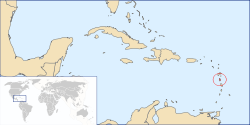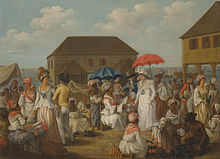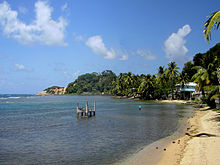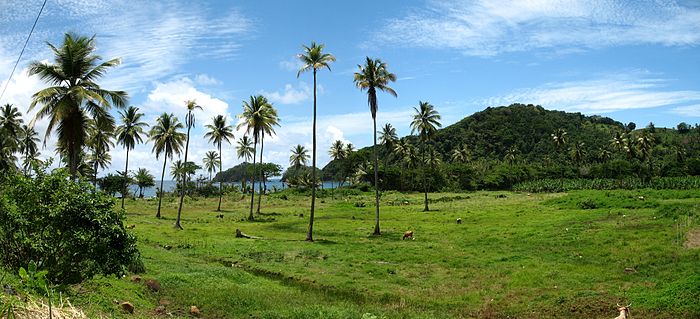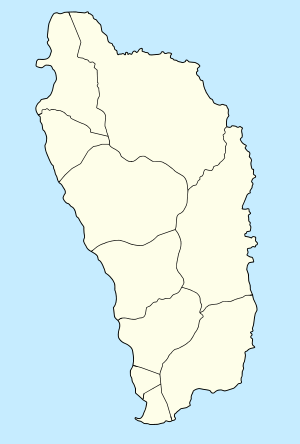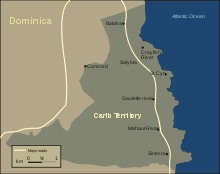
Dominica
Background to the schools Wikipedia
SOS Children produced this website for schools as well as this video website about Africa. With SOS Children you can choose to sponsor children in over a hundred countries
Coordinates: 15°25′00″N 61°20′00″W
| Commonwealth of Dominica Waitukubuli
|
||||||
|---|---|---|---|---|---|---|
|
||||||
Motto:
|
||||||
| Anthem: Isle of Beauty, Isle of Splendour | ||||||
|
Location of Dominica in the Lesser Antilles of the Caribbean.
|
||||||
| Capital and largest city |
Roseau 15°18′N 61°23′W |
|||||
| Official languages | English | |||||
| Vernacular languages |
|
|||||
| Ethnic groups (2001) |
|
|||||
| Demonym | Dominican | |||||
| Government | Unitary parliamentary republic | |||||
| - | President | Eliud Williams | ||||
| - | Prime Minister | Roosevelt Skerrit | ||||
| Legislature | House of Assembly | |||||
| Independence | ||||||
| - | from the United Kingdom | 3 November 1978 | ||||
| Area | ||||||
| - | Total | 750 km2 ( 184th) 290 sq mi |
||||
| - | Water (%) | 1.6 | ||||
| Population | ||||||
| - | July 2009 estimate | 72,660 ( 195th) | ||||
| - | 2011 census | 71,293 | ||||
| - | Density | 105/km2 ( 95th) 272/sq mi |
||||
| GDP ( PPP) | 2012 estimate | |||||
| - | Total | $1.002 billion | ||||
| - | Per capita | $14,166 | ||||
| GDP (nominal) | 2012 estimate | |||||
| - | Total | $497 million | ||||
| - | Per capita | $7,022 | ||||
| HDI (2013) | high |
|||||
| Currency | East Caribbean dollar ( XCD) |
|||||
| Time zone | Eastern Caribbean ( UTC–4) | |||||
| Drives on the | left | |||||
| Calling code | +1-767 | |||||
| ISO 3166 code | DM | |||||
| Internet TLD | .dm | |||||
Dominica (pron.: / ˌ d ɒ m ɪ ˈ n iː k ə / DOM-i-NEE-kə; French: Dominique; Kali‘na (Carib): Wai‘tu kubuli), officially the Commonwealth of Dominica, is an island nation in the Lesser Antilles region of the Caribbean Sea, south-southeast of Guadeloupe and northwest of Martinique. Its size is 750 square kilometres (290 sq mi) and the highest point in the country is Morne Diablotins, which has an elevation of 1,447 metres (4,747 ft). The Commonwealth of Dominica had a population of 71,293 at the 2011 Census. The capital is Roseau which is located on the leeward side of the island.
Dominica has been nicknamed the "Nature Isle of the Caribbean" for its unspoiled natural beauty. It is the youngest island in the Lesser Antilles, still being formed by geothermal-volcanic activity, as evidenced by the world's second-largest hot spring, Boiling Lake. The island features lush mountainous rainforests, home of many rare plant, animal, and bird species. There are xeric areas in some of the western coastal regions, but heavy rainfall can be expected inland. The Sisserou Parrot (also known as the Imperial Amazon), the island's national bird, is featured on the national flag. Dominica's economy is heavily dependent on both tourism and agriculture.
Christopher Columbus named the island after the day of the week on which he spotted it, a Sunday (dominica in Latin), November 3, 1493. In the hundred years after Columbus's landing, Dominica remained isolated, and even more Caribs settled there after being driven from surrounding islands as European powers entered the region. France formally ceded possession of Dominica to Great Britain in 1763. Great Britain then established a small colony on the island in 1805.
The emancipation of African slaves occurred throughout the British Empire in 1834, and, in 1838, Dominica became the first British Caribbean colony to have a legislature controlled by a black majority. In 1896, the United Kingdom reassumed governmental control of Dominica, turning it into a Crown colony. Half a century later, from 1958 to 1962, Dominica became a province of the short-lived West Indies Federation. On November 3, 1978, Dominica became an independent nation.
Etymology
The name Dominica comes from the Latin word for Sunday, which was the day on which it was spotted by Christopher Columbus. Its pre-Columbian name was “Wai‘tu kubuli”, which means “Tall is her body”. The indigenous people of the island, the Caribs, have the Carib Territory, a territory similar to the Indian reserves of North America. The official language is English in consequence of its history as a British colony, territory, and state, though a French creole is spoken by many, especially people of older generations. The demonym or adjective is "Dominican" in English, with the syllable stress being on the second "i" serving to distinguish it from same word used in reference to Dominican Republic, in which case the stress is on the first "i".
History
Early European contacts
In 1635, France claimed Dominica along with all the other 'Petite Antilles' but no settlement was attempted. Between 1642 and 1650 a French missionary Raymond Breton became the first regular European visitor to the island. In 1660 the French and English agreed that both Dominica and St. Vincent should not be settled, but instead left to the Caribs as neutral territory. Dominica was officially neutral for the next century, but the attraction of its resources remained; rival expeditions of English and French foresters were harvesting timber by the start of the 18th century.
French colony
In 1715, the French established their first permanent settlements in Dominica following a revolt of "poor white" smallholders in the north of Martinique, known as La Gaoulé, which caused an exodus of them to southern Dominica. In 1727 the first French commander, M. Le Grand, took charge of the island with a basic French government thus making Dominica formally a colony of France and the island was divided into districts or "quarters". Already installed in Martinique and Guadeloupe, the French gradually implanted in Dominica by introducing the cultivation of coffee. They imported African slaves to fill the labor they needed. As part of the 1763 Treaty of Paris that ended the Seven Years' War, the island became a British possession. In 1778, during the American Revolutionary War, the French mounted a successful invasion with the active cooperation of the population. The 1783 Treaty of Paris, which ended the war, returned the island to Britain. French invasions in 1795 and 1805 ended in failure.
British colony
In 1763, the British established a legislative assembly, representing only the white population. In 1831, reflecting a liberalization of official British racial attitudes, the Brown Privilege Bill conferred political and social rights on free non-whites. Slavery was abolished in Dominica in 1834. Three African people were elected to the legislative assembly the following year. In 1838, Dominica became the only British Caribbean colony to have an African-controlled legislature in the 19th century. Following the abolition of slavery, many slaves fled from the neighboring islands of Martinique and Guadeloupe, using makeshift, trying to find refuge in Dominica. Most African legislators were smallholders or merchants who held economic and social views diametrically opposed to the interests of the small, wealthy English planter class. Reacting to a perceived threat, the planters lobbied for more direct British rule.
In 1865, after much agitation and tension, the colonial office replaced the elective assembly with one that had one-half of members who were elected and one-half who were appointed. Planters allied with colonial administrators outmaneuvered the elected legislators on numerous occasions. In 1871, Dominica became part of the Leeward Island Federation. The power of the African population progressively eroded. Crown Colony government was re-established in 1896. All political rights for the vast majority of the population were effectively curtailed. Development aid, offered as compensation for disenfranchisement, proved to have a negligible effect.
History post-1900
Following World War I, an upsurge of political consciousness throughout the Caribbean led to the formation of the Representative Government Association. Marshalling public frustration with the lack of a voice in the governing of Dominica, this group won one-third of the popularly elected seats of the legislative assembly in 1924 and one-half in 1936. Shortly thereafter, Dominica was transferred from the Leeward Island Administration and was governed as part of the Windwards until 1958, when it joined the short-lived West Indies Federation.
After the federation dissolved, Dominica became an associated state of the United Kingdom in 1967 and formally took responsibility for its internal affairs. On November 3, 1978, the Commonwealth of Dominica was granted independence by the United Kingdom.
Independence did little to solve Dominica's problems, and in mid-1979, political discontent led to the formation of an interim government. It was replaced after the 1980 elections by a government led by the Dominica Freedom Party under Prime Minister Eugenia Charles, the Caribbean's first female prime minister. Chronic economic problems were compounded by the severe impact of hurricanes in 1979 and in 1980.
In 1981, Dominica was threatened with a takeover by mercenaries. In 1981, a group of " mercenaries" led by Mike Perdue of Houston and Wolfgang Droege of Toronto, attempted to overthrow the government of Eugenia Charles. The North America mercenary group was to aid ex-Prime Minister Patrick John and his Dominica Defence Force in regaining control of the island in exchange for control over the island's future development. The entire plan failed and the ship hired to transport the men of Operation Red Dog never even made it off the dock as the FBI was tipped off. The self-titled mercenaries lacked any formal military experience and/or training and the majority of the crew had been misled into joining the armed coup by the con-man ringleader Mike Perdue. White nationalist Don Black was also jailed for his part in the attempt, which violated US neutrality laws. The book Bayou of Pigs, written by Stewart Bell, details the story of this misguided attempt to turn Dominica into a criminal paradise.
By the end of the 1980s, the economy recovered, but weakened again in the 1990s because of a decrease in banana prices.
In the January 2000 elections, the Edison James United Workers Party (UWP) was defeated by the Dominican Labour Party (DLP), led by Roosevelt P. "Rosie" Douglas. Douglas died after only a few months in office and was replaced by Pierre Charles, who died in office in January 2004. Roosevelt Skerrit, also of the DLP, replaced Charles as Prime Minister. Under Prime Minister Skerrit's leadership, the DLP won elections in May 2005 that gave the party 12 seats in the 21-member Parliament to the UWP's 8 seats. An independent candidate affiliated with the DLP won a seat as well. Later, the independent candidate joined the government and one UWP member crossed the aisle, making the total 14 seats for the DLP and 7 for the UWP.
The DLP won a crushing victory in elections in December 2009, winning 18 of 21 seats. The UWP claimed campaign improprieties and boycotted Parliament; by-elections were conducted for two of its seats in July 2010, and the UWP once again won the seats. On the 17th of September 2012 Eliud Thaddeus Williams was sworn in as President, replacing Dr Nicholas Liverpool who was reportedly removed from office due to ill health.
Geography and climate
Dominica is an island nation and borderless country in the Caribbean Sea, the northernmost of the Windward Islands (though it is sometimes considered the southernmost of the Leeward Islands). The size of the country is about 289.5 square miles (750 km2). The capital is Roseau.
Dominica is largely covered by rainforest and is home to the world's second-largest hot spring, Boiling Lake. Dominica has many waterfalls, springs, and rivers. The Calibishie area in the country's northeast has sandy beaches. Some plants and animals thought to be extinct on surrounding islands can still be found in Dominica's forests. The volcanic nature of the island has attracted scuba divers. The island has several protected areas, including Cabrits National Park, as well as 365 rivers.
On his second voyage to the Caribbean, Dominica was the first New World country that Christopher Columbus discovered. It is said that when his royal sponsors asked Christopher Columbus to describe this island, he crumpled a piece of parchment roughly and threw it on the table. "This", Columbus explained, "is what Dominica looks like—completely covered with mountains with nary a flat spot."
Morne Trois Pitons National Park is a tropical forest blended with scenic volcanic features. It was recognised as a World Heritage Site on April 4, 1995, a distinction it shares with four other Caribbean islands.
The Commonwealth of Dominica is engaged in a long-running dispute with Venezuela over Venezuela's territorial claims to the sea surrounding Isla Aves (literally Bird Island, but in fact called Bird Rock by Dominica authorities), a tiny islet located 140 miles (225 km) west of the island of Dominica. Lighthouses of Aves Island
There are two primary population centres: Roseau (with 14,725 inhabitants in 2011) and Portsmouth (with 4,167 inhabitants in 2011).
Dominica, known as "The Nature Island of the Caribbean" due to its spectacular, lush, and varied flora and fauna, which are protected by an extensive natural park system; the most mountainous of the Lesser Antilles, its volcanic peaks are cones of lava craters and include Boiling Lake, the second-largest, thermally active lake in the world possesses the most pristine wilderness in the Caribbean. Originally, it was protected by sheer mountains which led the European powers to build ports and agricultural settlements on other islands. More recently, the citizens of this island have sought to preserve its spectacular natural beauty by discouraging the type of high-impact tourism which has damaged nature in most of the Caribbean.
Visitors can find large tropical forests, including one which is on the UNESCO list of World Heritage sites, hundreds of streams, coastlines and coral reefs.
The Sisserou parrot (Amazona imperialis) is Dominica's national bird and is endemic to its mountain forests. A related species, the Jaco or Red-necked Parrot (A. arausiaca),. is also a Dominican endemic. Both birds are rare and protected nowadays, though some forest is still threatened by logging in addition to the long-standing threat of hurricanes.
The Caribbean Sea offshore of the island of Dominica is home to many cetaceans. Most notably a group of sperm whales live in this area year round. Other cetaceans commonly seen in the area include spinner dolphins, pantropical spotted dolphins and bottlenose dolphins. Less commonly seen animals include killer whales, false killer whales, pygmy sperm whales, dwarf sperm whales, Risso's dolphins, common dolphins, Atlantic spotted dolphins, humpback whales and Bryde's whales. This makes Dominica a destination for tourists interested in whale-watching.
Dominica is especially vulnerable to hurricanes as the island is located in what is referred to as the hurricane region. In 1979, Dominica was hit directly by category 5 Hurricane David, causing widespread and extreme damage. On August 17, 2007, Hurricane Dean, a category 1 at the time, hit the island. A mother and her seven-year-old son died when a landslide caused by the heavy rains crushed their house. In another incident two people were injured when a tree fell on their house. Prime Minister Roosevelt Skerrit estimated that 100 to 125 homes were damaged, and that the agricultural sector was extensively damaged, in particular the banana crop.
Government and administrative divisions
Dominica is a parliamentary democracy within the Commonwealth of Nations and, since 1979, a member of La Francophonie. The Commonwealth of Dominica is one of the Caribbean's few republics. The president is the head of state, while executive power rests with the cabinet, headed by the prime minister. The unicameral parliament consists of the thirty-member House of Assembly, which consists of twenty-one directly elected members and nine senators, who may either be appointed by the president or elected by the other members of the House of Assembly.
Unlike other former British colonies in the region, Dominica was never a Commonwealth realm, instead becoming a republic on independence. Dominica is a full and participating member of the Caribbean Community (CARICOM) and the Organisation of Eastern Caribbean States (OECS).
Dominica is also a member of the International Criminal Court with a Bilateral Immunity Agreement of protection for the U.S. military, as covered under Article 98. In January 2008 Dominica joined the Bolivarian Alternative for the Americas.
Dominica is divided into ten parishes, given below with their 2011 Census populations:
|
|
Economy
In 2008, Dominica had one of the lowest per capita gross domestic product (GDP) rates of Eastern Caribbean states. The country nearly had a financial crisis in 2003 and 2004, but Dominica's economy grew by 3.5% in 2005 and 4.0% in 2006, following a decade of poor performance. Growth in 2006 was attributed to gains in tourism, construction, offshore and other services, and some sub-sectors of the banana industry. The International Monetary Fund (IMF) recently praised the Government of Dominica for its successful macroeconomic reforms. The IMF also pointed out remaining challenges, including the need for further reductions in public debt, increased financial sector regulation, and market diversification.
Bananas and other agriculture dominate Dominica's economy, and nearly one-third of the labour force works in agriculture. This sector, however, is highly vulnerable to weather conditions and to external events affecting commodity prices. In 2007, Hurricane Dean caused significant damage to the agricultural sector as well as the country's infrastructure, especially roads. In response to reduced European Union (EU) banana trade preferences, the government has diversified the agricultural sector by promoting the production of coffee, patchouli, aloe vera, cut flowers, and exotic fruits such as mango, guava, and papaya. Dominica has also had some success in increasing its manufactured exports, primarily soap.
Dominica is mostly volcanic and has few beaches; therefore, tourism has developed more slowly than on neighboring islands. Nevertheless, Dominica's mountains, rainforests, freshwater lakes, hot springs, waterfalls, and diving spots make it an attractive eco-tourism destination. Cruise ship stopovers have increased following the development of modern docking and waterfront facilities in Roseau, the capital. Out of 22 Caribbean islands tracked, Dominica had the fewest visitors in 2008 (55,800 or 0.3% of the total). This was about half as many as visited Haiti.
Dominica's currency is the East Caribbean Dollar.
Dominica is a beneficiary of the Caribbean Basin Initiative (CBI) that grants duty-free entry into the United States for many goods. Dominica also belongs to the predominantly English-speaking Caribbean Community (CARICOM), the CARICOM Single Market and Economy (CSME), and the Organisation of Eastern Caribbean States (OECS).
Dominica supposedly offers tax-free status to companies locating from abroad. It is not known how many companies benefit from the tax-free status because of the strict confidentiality the government enforces, although it is known many Internet businesses utilise Dominica for this reason. However, on 12 July 2012 Dominica signed an agreement with Poland to exchange tax information.
The Commonwealth of Dominica offers an official and legally mandated economic citizenship to those seeking a valid second passport. The nationality law of Dominica authorizes the government to waive the normal requirement of seven years of legal residence to acquire citizenship in exchange for a cash contribution. Total costs including all fees for a single applicant come to about $105,000, with an additional $25,000 specified for a spouse and up to two children under 18. The Dominican passport holders can travel without a visa, or obtain a visa upon entry, to nearly 90 countries and territories. Applying for Dominica citizenship requires interacting with official Government Approved Economic Citizenship Agents.
Infrastructure
Air
There are two small airports on the island. The primary airport, Melville Hall Airport (DOM), is on the northeast coast and is about a 45-minute drive from Portsmouth. The second is Canefield Airport (DCF), about 15 minutes from Roseau on the southwest coast. Melville Hall Airport is suitable for limited use of commercial jets because of runway length. Melville Hall currently has regular service by American Eagle, Winair, and LIAT using twin turboprop aircraft like the De Havilland Dash 8, as well as Conviasa and Amerijet, which, using Boeing 727 Freighters, is the only airline with jet service to the republic. A runway extension and service upgrade project began at Melville Hall around 2006 and was finished in 2010.
Roads
The only major highway on the island is the road between Portsmouth and Roseau. It takes about one hour to drive from Portsmouth to Roseau. Private minibuses form the major public transport system. However, this "highway" was under major reconstruction via help from the Chinese and was completed in April 2012 - highway completed. The other roads on the island are generally in deplorable condition with little prospect for improvement.
Demographics
The vast majority of Dominicans are of African descent. There is a significant mixed population, along with Indo-Caribbean or East Indian groups, a small European origin minority (descendants of French, British, and Irish colonists) and there are small numbers of Lebanese, Syrians and Asians. Dominica is also the only Eastern Caribbean island that still has a population of pre-Columbian native Caribs, who were exterminated or driven from neighbouring islands. There are only about 3,000 Caribs remaining. They live in eight villages on the east coast of Dominica. This special Carib Territory was granted by the British Crown in 1903. There are also about 1,000 medical students from the United States and Canada who study at the Ross University School of Medicine in Portsmouth.
The population growth rate of Dominica is very low, due primarily to emigration to other countries. In the early 21st century, emigrant numbers for the most popular countries are as follows: the United States (8,560), the United Kingdom (6,739), Canada (605) and France (394).
It has recently been noted that Dominica has a relatively large number of centenarians. As of March 2007, there are 22 centenarians out of the island's 70,000 inhabitants—three times the average incidence of centenarianism in developed countries. The reasons for this are the subject of current research being undertaken at Ross University School of Medicine.
About 80% of the population is Roman Catholic, though in recent years a number of Protestant churches have been established. There is also a small Muslim community in Dominica, and the nation's first mosque was built recently near Ross University.
English is the official language of Dominica and is universally spoken and understood. However, because of historic French occupation during different times in history, and the island's location between the two French-speaking departments of Martinique and Guadeloupe, Antillean Creole, based on French, is spoken by many people on the island, especially from the older generation. Because of a decline in its usage by the younger generation, initiatives have been set up in an effort to increase usage and promote this unique part of the nation's history and culture. The dialect of Dominica also includes Kokoy, along with Creole—French-based patois. Cocoy, or Kokoy, is a mix of Leeward Island English-Creole and Dominican Creole. It is mainly spoken in the north-eastern villages of Marigot and Wesley. As a result of this admixture of languages and heritage, Dominica is a member of both the English-speaking Commonwealth of Nations and the French-speaking La Francophonie.
At the beginning of the twentieth century the Rose's Company, which produced Rose's lime juice, saw demand for its product outgrow its ability to supply the product from Montserrat. Their response to the situation was to buy land on Dominica and encourage Montserrat farm labourers to relocate. As a result there came to be two linguistic communities in Dominica. Over time there has been much intermarrying, but there are still traces of difference in origin.
Largest cities
Culture
Dominica is home to a wide range of people. Although it was historically occupied by several native tribes, the Arawaks and Kalinago Carib tribes remained by the time European settlers reached the island. "Massacre" is a name of a river dedicated to the murders of the Native villagers by French and British settlers, because the river ran red with blood for days. Each (French and British) claimed the island and imported slaves from Africa. The remaining Caribs now live on a 3,700-acre (15 km2) territory on the east coast of the island. They elect their own chief. This mix of cultures is important to Dominica.
Music and dance are important facets of Dominica's culture. The annual independence celebrations show an outburst of traditional song and dance preceded since 1997 by weeks of Creole expressions such as "Creole in the Park" and the "World Creole Music Festival". Dominica gained prominence on the international music stage when in 1973, Gordon Henderson founded the group Exile One and an original musical genre which he coined " Cadence-lypso" which paved the way for modern Creole music. Other musical genres include "Jing ping" and " Cadence". Jing ping heavily features the accordion and is native to the island. Dominica's music is an intoxicating melange of Afro-Cuban, African and European traditions. Popular artists over the years include Chubby and the Midnight Groovers, Bells Combo, the Gaylords, WCK, and Triple Kay.
The 11th annual World Creole Music Festival was the first activity held there since its completion on October 27, 2007, part of the island's celebration of independence from Great Britain on November 3. A year-long reunion celebration began in January 2008 marking 30 years of independence.
Dominica is often seen as a society that is migrating from collectivism to that of individualism. The economy is a developing one that previously depended on agriculture. Signs of collectivism are evident in the small towns and villages which are spread across the island.
Dominican cuisine is similar to that of other Caribbean countries. Common main courses comprise meat (usually chicken, but can be goat, lamb, or beef) covered in sauce. The sauces are either spicy pepper sauces, or concoctions made from local fruit. A huge variety of local fruit, from tamarind to passion fruit, are served on the island, usually in juice or sauce form. Soursop is peeled and eaten raw. Sorrel, a red flower that only blooms around Christmas, is boiled into a bright red drink. Typical dishes include "pelau", a one-pot dish of rice and chicken, mountain chicken (frog), all types of local fish, frozen joys (a homemade flavored popsicle), and several types of "ground provisions"—root vegetables including dasheen and tania.
The famed novelist Jean Rhys was born and raised in Dominica. The island is obliquely depicted in her best-known book, Wide Sargasso Sea. Rhys's friend, the political activist and writer Phyllis Shand Allfrey, set her 1954 novel, The Orchid House ( ISBN 0-8135-2332-X), in Dominica.
Education
The island has its own state college, formerly named Clifton Dupigny Community College. Some Dominicans get scholarships from the Cuban government to attend universities in Cuba. Others go to the University of the West Indies or to schools in the United Kingdom, the United States, or other countries for higher education. Ross University, a medical school, is located at Portsmouth. The Archbold Tropical Research and Education Centre (ATREC), a biological field station owned by Clemson University, is located at Springfield Estate between Canefield and Pond Cassé. In 2006, another medical school called All Saints University School of Medicine opened in temporary facilities in Loubiere, with a permanent campus being constructed in Grand Bay. Currently All Saints is located in Roseau, Dominica. Until 2009 there was also a marine biology institute in Mahaut, I.T.M.E (Institute for Tropical Marine Ecology), 15 minutes north of Roseau.
Cricket
Cricket is a popular sport on the island, and Dominica competes in test cricket as part of the West Indies cricket team. On October 24, 2007, the 8,000-seat Windsor cricket stadium was completed with a donation of EC$33 million (US$17 million, €12 million) from the government of the People's Republic of China.

